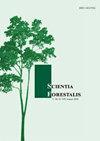Vegetation cover arrangements in the recovery of degraded areas in the Brazilian semi-arid region: effect on soil chemical and physical properties
IF 0.4
4区 农林科学
Q4 FORESTRY
引用次数: 0
Abstract
Vegetation cover arrangements in the recovery of degraded areas in the Brazilian semi-arid region: effect properties. Abstract Soil chemical and physical attributes can be considered one of the main indicators of soil quality and can be useful in monitoring and diagnosing the current condition of a degraded area. The objective of this study was to evaluate the use of herbaceous plants native to the semi-arid region in the recovery of degraded areas through changes in soil chemical and physical attributes in areas altered by the implementation of the São Francisco River Integration Project (SFIP). The experiment was carried out in Cabrobó, Brazil, in the North Axis. The herbaceous plants were sown in an intercropping, totaling 16 treatments (15 densities and the control) distributed in four blocks. Three soil samples were taken and soil chemical and physical attributes were determined. Two statistical analyses were performed, the first one in a randomized block design (RBD) with 16 treatments (densities) and four replications, and the second one, analyzing the sampling times (control, second and third samplings) in the four intercropping blocks. Changes in soil attributes due to area recovery practices were found in the surface layer. Although there was no statistical difference between the cover plants used, there was a temporal change in some chemical attributes, such as SOM, K + , Mg 2+, and P, which showed an increase between the control and the second sampling, in addition to a reduction between the second and third samplings. Thus, the recovery of the soils of areas altered by the SFIP should be carried out continuously until the stabilization of the ecological system. testemunha e a segunda amostragem. Dessa forma, a recuperação dos solos das áreas alteradas pelo PISF deverá ocorrer continuamente até a estabilização do sistema ecológico. Palavras-chave: Degradação ambiental; Raphiodon echinus ; Senna uniflora ; Tridax procumbens .巴西半干旱区退化地区恢复中的植被覆盖安排:对土壤化学和物理性质的影响
巴西半干旱区退化地区恢复中的植被覆盖安排:效应特性。土壤理化属性是土壤质量的主要指标之一,可用于监测和诊断退化地区的现状。本研究的目的是通过实施奥弗朗西斯科河一体化项目(SFIP)改变的地区土壤化学和物理属性的变化,评估半干旱区原生草本植物在退化地区恢复中的应用。草本植物采用间作方式,共16个处理(15个密度和对照),分布在4个小区。取3个土壤样品,测定土壤理化性质。采用16个处理(密度)、4个重复的随机区设计(RBD)和4个间作区取样次数(对照、第二次和第三次取样)进行统计分析。由于面积恢复措施,土壤属性在表层发生了变化。虽然不同覆盖植物间没有统计学差异,但土壤有机质、钾离子、镁离子和磷等化学属性在时间上发生了变化,在对照和第二次取样之间有所增加,在第二次和第三次取样之间有所减少。因此,应持续进行受SFIP影响地区的土壤恢复,直至生态系统稳定。testemuna有一个第二步。Dessa forma,一个恢复的apr o do solos das áreas alteradas pelo PISF dever ocorcontinuentatvea estilizapr o do sistema ecológico。palavras - have:退化的;棘齿蛇;单叶番泻;原藜草。
本文章由计算机程序翻译,如有差异,请以英文原文为准。
求助全文
约1分钟内获得全文
求助全文
来源期刊

Scientia Forestalis
Agricultural and Biological Sciences-Forestry
CiteScore
1.00
自引率
0.00%
发文量
39
期刊介绍:
Scientia Forestalis is a scientific publication of the IPEF – Institute of Forest Research and Studies, founded in 1968, as a nonprofit institution, in agreement with the LCF – Department of Forest Sciences of the ESALQ – Luiz de Queiroz College of Agriculture of the USP – São Paulo University. Scientia Forestalis, affiliated to the ABEC – Brazilian Association of Scientific Publishers, publishes four issues per year of original papers related to the several fields of the Forest Sciences.
The Editorial Board is composed by the Editor, the Scientific Editors (evaluating the manuscript), and the Associated Editors (helping on the decision of acceptation or not of the manuscript, analyzed by the Peer-Reviewers.
 求助内容:
求助内容: 应助结果提醒方式:
应助结果提醒方式:


